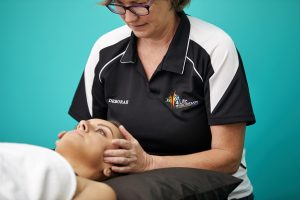Ankle sprains — they’re one of those injuries that can happen to anyone, whether you’re chasing a footy, stepping off a curb awkwardly, or simply landing the wrong way. While the initial pain, swelling and hobbling usually get our attention, there’s a vital piece of the recovery puzzle that often gets missed: proprioception.
What on Earth Is Proprioception?
Proprioception is your body’s in-built GPS. It helps you know where your limbs are and how they’re moving — without needing to look. Thanks to tiny receptors in your muscles, tendons and ligaments, your brain constantly gets updates about your joint positions.
But when you injure your ankle ligaments, those receptors can get damaged or a bit scrambled. Even after the swelling goes down and the pain eases, your ankle might still feel wobbly or unreliable — and that can set you up for more injuries down the track.

So Why Does Proprioceptive Training Matter?
Research shows that people who don’t address proprioception after an ankle sprain are more likely to sprain it again. That’s because even minor issues with balance and joint awareness can throw off your coordination, reaction times, and movement patterns — especially during sport or when the ground catches you off guard.
Here’s how proprioceptive training helps:
- Boosts balance and coordination
- Sharpens your reaction to sudden movements
- Builds joint stability
- Lowers your risk of re-injury
- Prepares athletes to return to peak performance
What Does Proprioceptive Training Actually Look Like?
Once you’re past the worst of the pain and swelling, your physio will likely introduce exercises that progress in difficulty — starting simple and becoming more dynamic as you get stronger.

🔹 Early Days: Laying the Groundwork – These exercises gently wake up your sense of balance without putting too much stress on your ankle.
- Seated weight shifts: Gently rock your weight side-to-side and front-to-back while sitting.
- Supported single-leg balance: Stand on your injured foot while holding onto a wall or bench for support.
🔹 Mid Stage: Step It Up – Now it’s time to challenge your control and retrain those stabilising reflexes.
- Single-leg balance (no hands!): Try standing unaided, and if you’re feeling brave, close your eyes or turn your head.
- Wobbly surface work: Stand on a foam mat, wobble board or even a folded towel.
🔹 Return to Play: Ready for Anything – This phase is all about preparing for real-world movements — think jumping, dodging, and quick turns.
- Hopping drills: Hop in all directions using the injured leg.
- Agility work: Practice ladder footwork, cone drills and rapid direction changes.
Quick Tips for Best Results
- Little and often: Consistent short sessions beat long, infrequent ones.
- Don’t rush: Move to the next level only when you’re steady and pain-free.
- Make it part of your day: Try balancing on one leg while brushing your teeth or waiting for the kettle.
- Listen to your body: Challenge yourself but stop if something hurts.
Why Seeing a Physio Makes All the Difference
A physiotherapist isn’t just there to hand you exercises. They assess how your ankle is healing, identify any weak points in your balance or stability, and tailor a program to help you move well — not just pain-free, but confidently.
From the early stages to sport-specific drills, your physio knows when and how to progress your rehab so you don’t just recover — you thrive.
Sprained an ankle recently? Don’t let it become a recurring issue. Book in with one of our physiotherapists to get started on your proprioceptive rehab journey. Your future self will thank you — especially the next time you step off that curb.
By Gary Stevens – Physiotherapist





